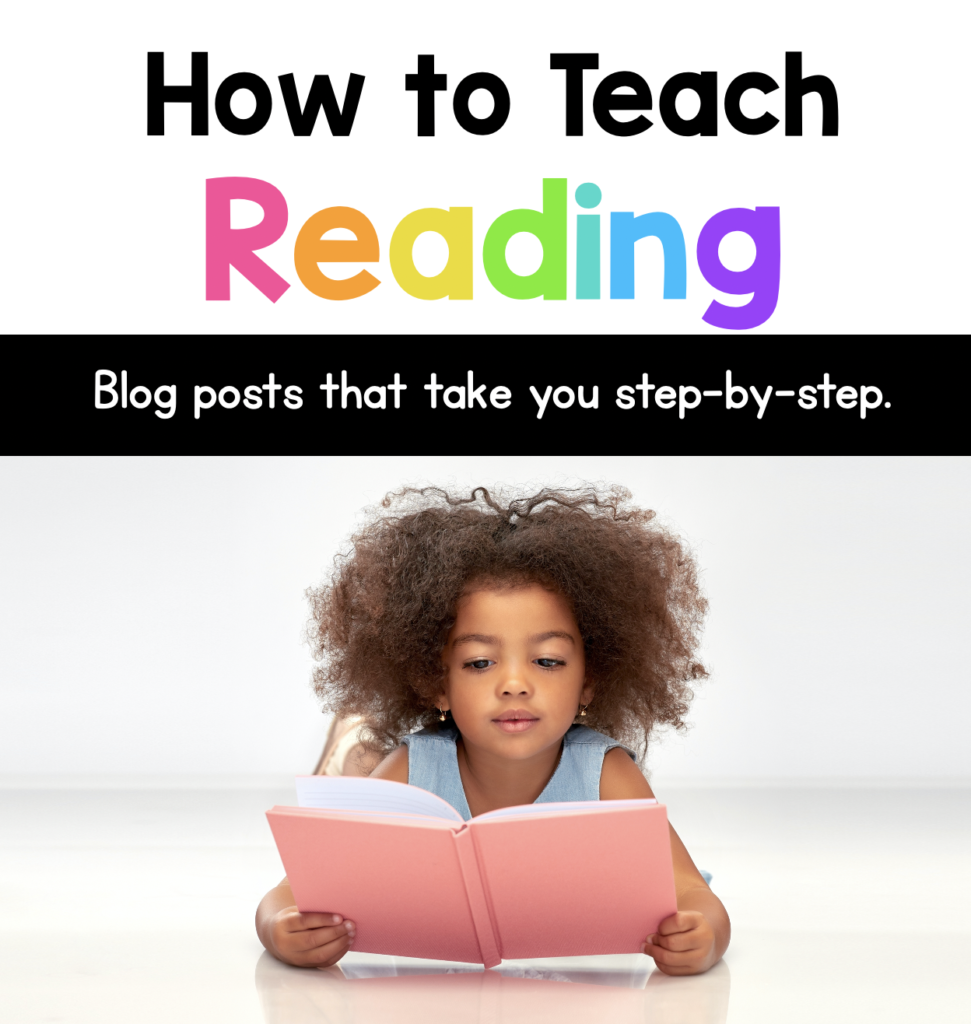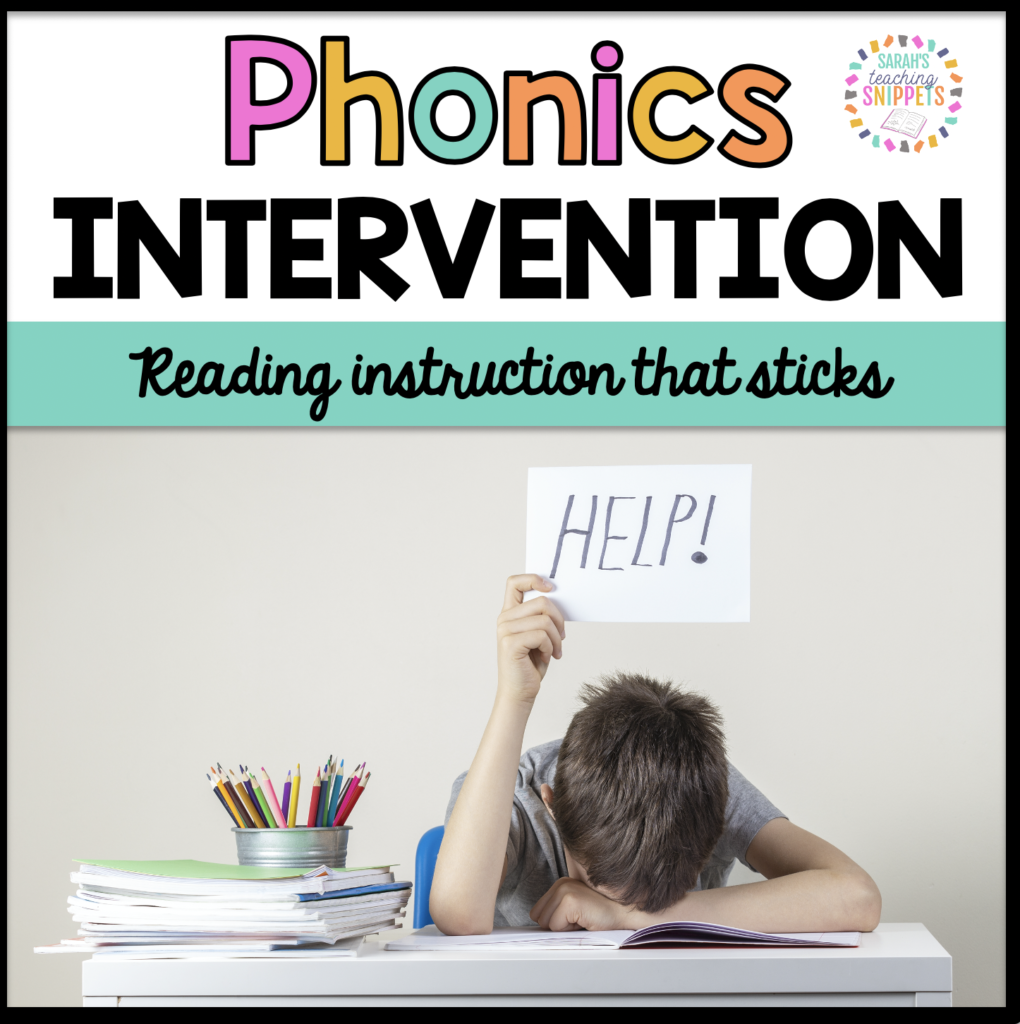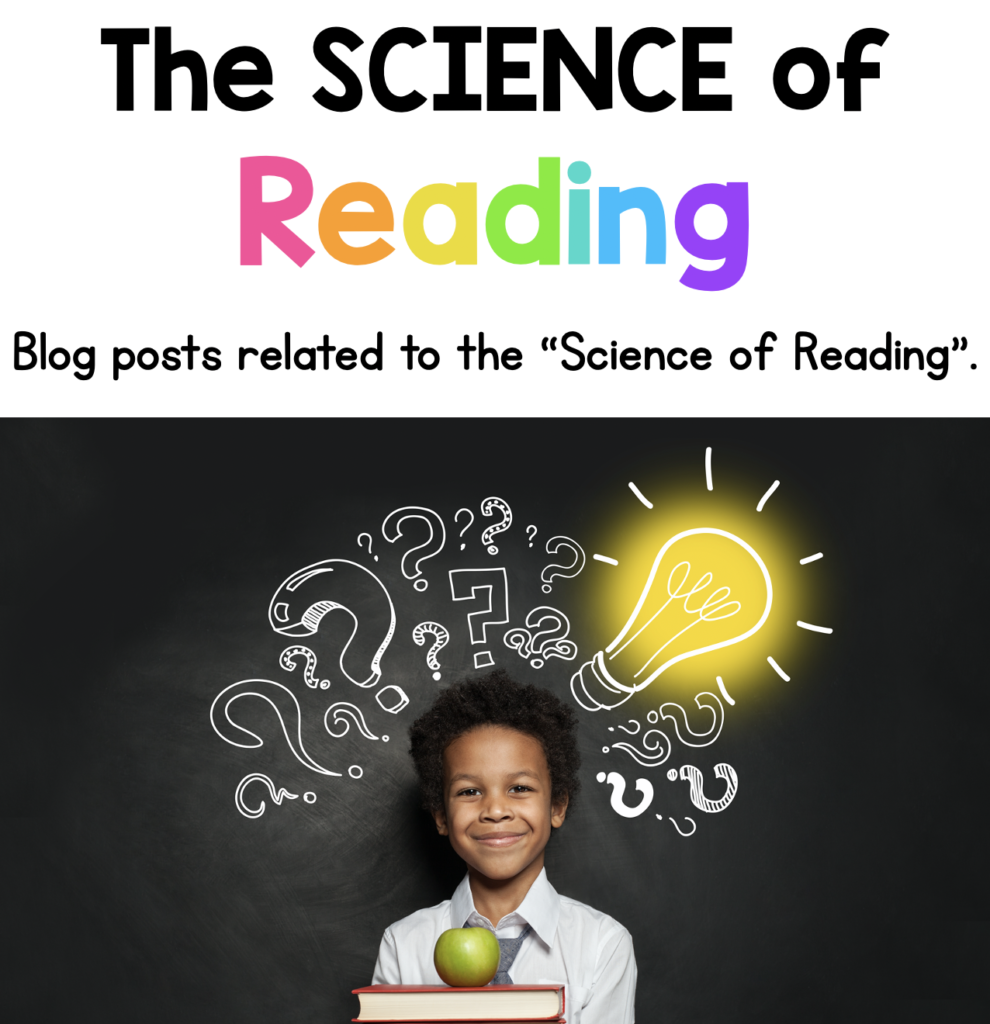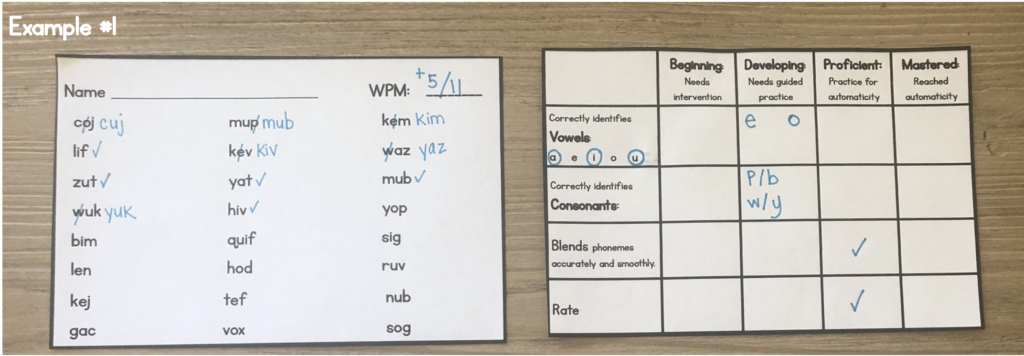Hello! This post is all about interpreting your phonics assessments to best meet the needs of your students. We can learn so much from these!
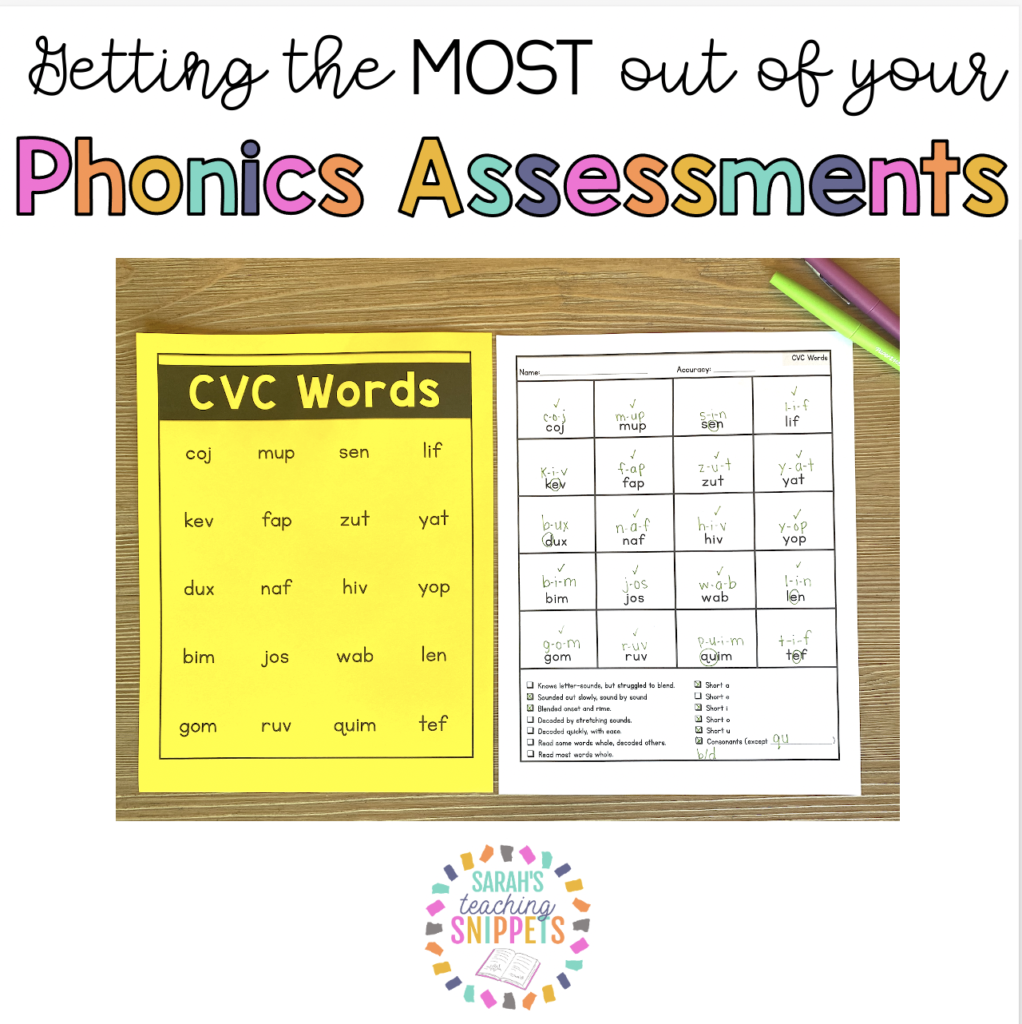
When to Use Phonics Assessments
There are two different instances where I use a phonics assessment:
- A Phonics Diagnostic is done at the beginning of the year. it includes several different phonics skills. The goal is to figure out what phonics skills my students have and don’t have. It gives me a starting point for my instruction. I also call it a Phonics Placement Assessment because it helps me place my students in the right part of my scope and sequence.
- The other kind is more of a Skill Check that I use after I have taught a specific skill. This assessment helps me to see how well I taught the skill to my students and where they are at with their proficiency with that skill. For example, after my silent e unit, I will give an assessment focusing on silent e words.
Types of Phonics Assessments
There are two ways that I assess phonics skills: A word assessment and a sentence reading assessment.
The nonsense word assessment shows me accuracy with applying a particular phonics skill. Specifically, it shows me which graphemes they know, which phonics patterns they recognize, and how proficient they are with phoneme blending.
The sentence reading assessment shows me how automatic they are with applying those skills with connected text. I get a glimpse into where they are at with fluency as well. Sometimes, a student has the accuracy with isolated words, but then they struggle at the sentence level. This shows me that they have learned the actual skill, but still need more time applying that skill.
Word Assessments
When it comes to a word assessment, I often use nonsense words. I do not use nonsense words often in my teaching, but it is helpful for an assessment because I am looking at their knowledge and application of specific phonics skills, not necessarily their word recognition skills. Some kids may have some words memorized, but they may not have good decoding skills or knowledge of certain phonics patterns or graphemes.
A phonics assessment must be given one -on-one. While the student is reading the words from their own copy, the teacher is following along on the teacher sheet.
This first example show what a Phonics Diagnostic may look like. There is a variety of skills included.
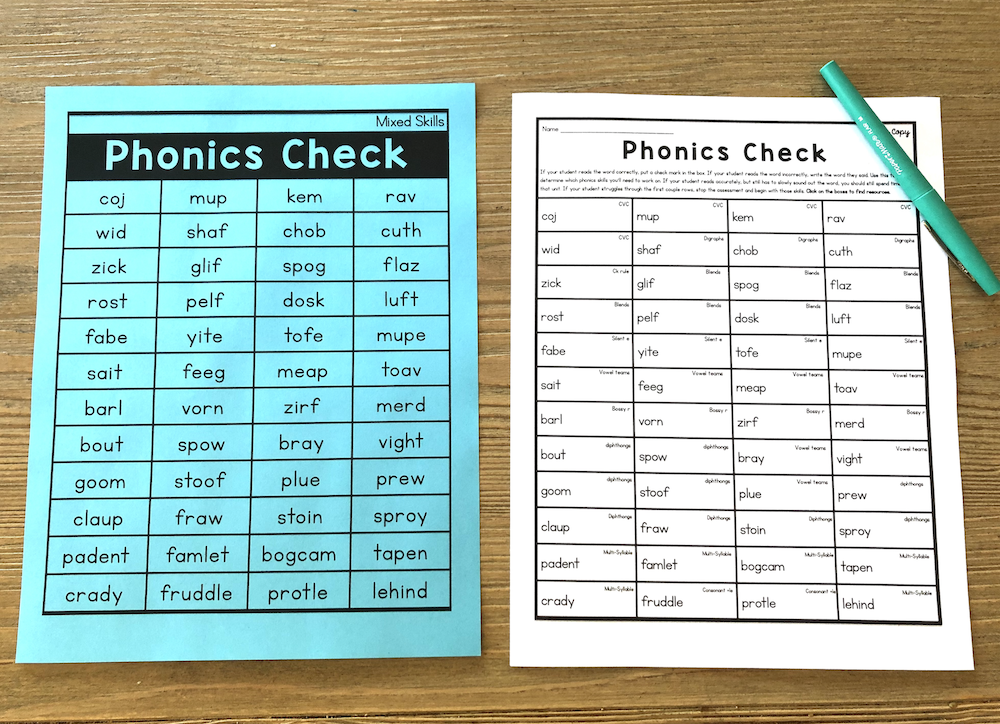
This next example focuses on a specific skill (silent e words). This would be used after teaching silent e.

How to Read Your Phonics Assessment
To fully utilize this assessment, don’t just look at correct or incorrect. Take notes about:
- The sounds they make for each letter. (sound-symbol knowledge)
- The student’s ability to blend phonemes (After they have identified the sounds in the word, can they blend those sounds together to make a whole word? This is a phonemic awareness skill.)
- The student’s automaticity with identifying sounds. (This shows you how strong their sound-symbol knowledge is. Is it automatic or does it take a moment to retrieve the sound associated with the letter?)
- The student’s rate and strategy for reading each word. (Do they go sound by sound, read onset-rime and then blend, or are they reading the whole word).
- The student’s orthographic knowledge. For example, do they know that when they see the vowel-consonant-e pattern, the first vowel will usually make its long sound, and the e will be silent?
Taking Notes during a Phonics Assessment
The picture below shows you some common examples of notes I would take.

- To show that the student sounded out each sound for the first word, I write c-o-j.
- To show that the sounds were blended correctly and the word was read accurately, I put a check mark in that box.
- To show that “mup” was read as onset and rime, I wrote m-up.
- To show that the student gave the wrong sound for the letter <e>, I circled it and then wrote what the student did say above it.
- If a student were to read the word whole without decoding at all, I would simply put a checkmark.
- The word “quim” shows that the student said /p/ /u/ /i/ /m/ but did not attempt to blend the sounds.
- If a student were to make a long vowel sound instead of a short vowel sound, I would indicate that with the long vowel symbol (a macron).
By taking these detailed notes, I learn a lot more about my student’s reading ability. If I just look at accuracy, I would know they read 75% accuracy. That tells me very little! Instead, I know that this student can, in fact, decode CVC words accurately. Their errors were all related to short e and one was a b/d confusion. They are proficient with the other short vowel sounds and all consonant sounds, except qu. I also know they are far from automatic, relying mainly on sounding out every sound. However, they are starting to read with onset and rime, which is great! There are more strengths here than deficits, but simply settling with 75% accuracy doesn’t give me that whole picture.
Learning From Your Assessment
Some questions I ask myself when analyzing a phonics word reading assessment are:
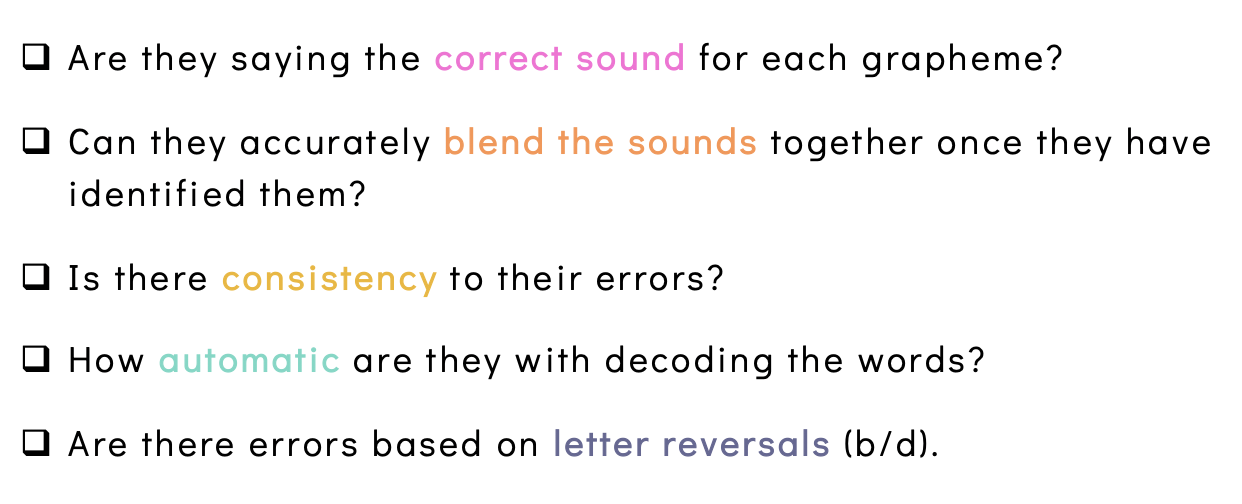
I ask myself these questions to help identify a student’s area of need:
- Are they mixing up VOWEL sounds?
- Yes: Give additional instruction or practice with vowels. Identify which vowels your student is having trouble with. Determine if it is all vowels or if there is a specific vowel that they need to work on.
- No: Check something else.
- Are they saying the correct SOUND for each grapheme?
- Yes: Check something else.
- No: Identify which letter or grapheme they do not know. Then, provide practice with those graphemes. Check to see if there are confusions with voiced and unvoiced pairs (j/ch, d/t, b/p, v/f, z/s, g/k).
- Is there CONSISTENCY to their errors?
- Yes: Target those skills for further practice.
- No: Provide intervention for phonemic awareness, sound/symbol, and decoding.
- Can they BLEND sounds together?
- Yes: Check something else.
- No: Provide additional support with phonemic awareness, specifically with blending and segmenting phonemes. Continue practicing decoding as long as they are proficient with letter identification. Work on encoding (spelling). Use phoneme-grapheme mapping. Teach decoding strategies like successive blending and continuous blending.
- Are they AUTOMATIC with identifying and blending sounds to read the word?
- Yes: They are proficient and ready for the next phonics skill.
- No: Continue to provide plenty of guided and independent practice to improve automaticity. Sometimes practicing onset and rime can help with this. Begin each session with a visual drill where you show a grapheme, and students say the sound. Have your student do letter automaticity drills and blends drills. Repetition with sound-symbol identification and decoding practice is key!
- Are the errors related to a phonics pattern or generalization? (For example, they are reading silent e words with a short vowel sound or using the /k/ sound for words with <ce>.)
- Yes: Teach that phonics pattern or generalization.
This flow chart is another way of basically saying the same thing as above, just in a more visual way:
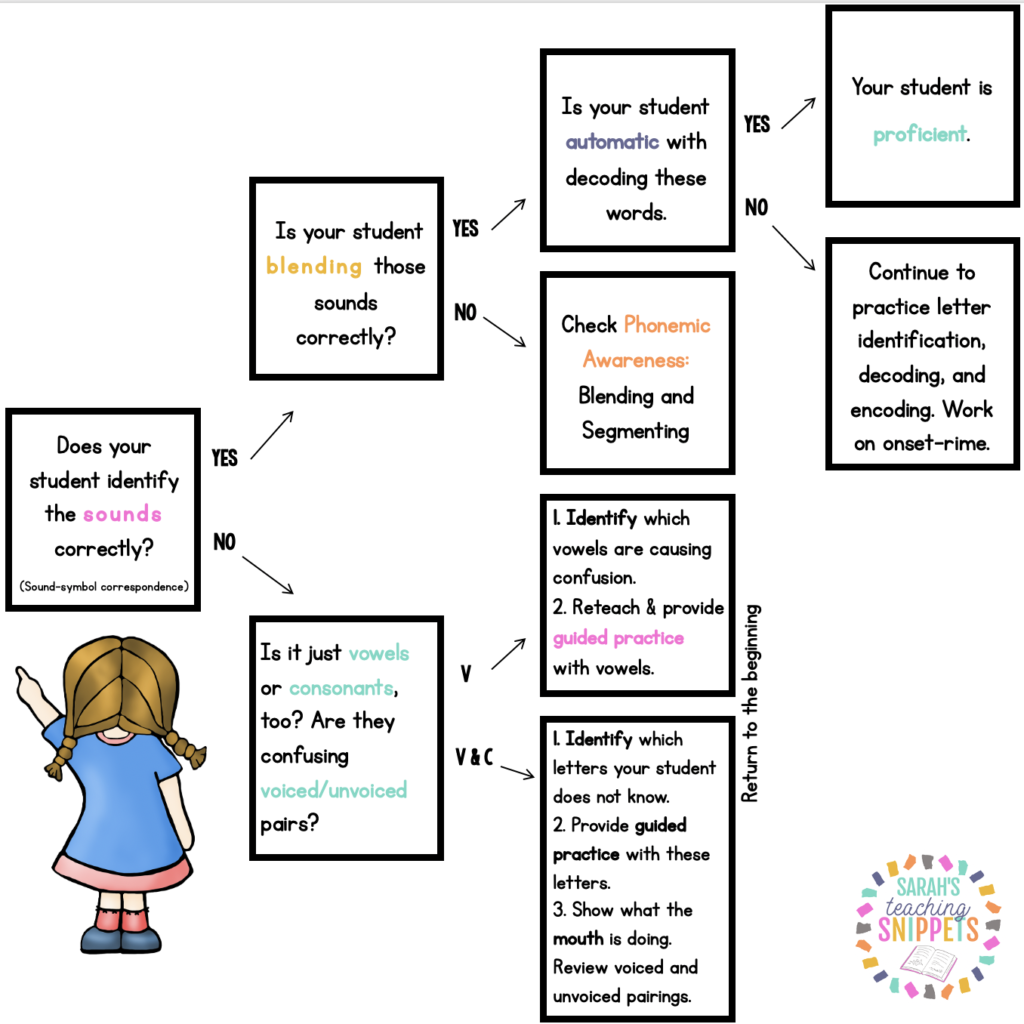
Phonics Word Assessment Examples
The following examples will help illustrate what I may learn from this assessment, as well as what it will lead me to do instructionally.
Example #1
What this Assessment Tells You:
- Strengths: This student is able to blend the sounds at a decent rate for this point in the year. This tells me that the problem is not phoneme blending.
- Areas of Need: In this example, the student’s errors are mainly due to vowel confusion. A couple of consonants are also mixed up.
Next Steps:
I would follow up with a quick sound-symbol assessment to see exactly which letter and sounds this student knows.
Instruction:
- If the student knows most of the letters of the alphabet (and the most common sounds), provide more instruction, modeling, and guided practice with those vowels and consonants that are not mastered. Additionally, continue to provide more practice with reading and spelling CVC words, especially with the vowels that the student often mixes up. A helpful resource can be found here.
- If the student is not automatic with letter-sound recognition, provide intervention with alphabet awareness.
Example #2:

What this assessment tells you:
- Strengths: This student identified all the letters and sounds correctly, so the problem is not with sound/symbol knowledge.
- Note: I wrote stop where the 1 minute time was up. I only had the students continue so I could see if he would identify the sounds in the next two words correctly.
- Areas of need: This student begins by saying the correct sounds for each letter, BUT when it is time to blend those sounds together, they are unable to do so. This is a phonemic awareness issue.
Next Steps:
Follow up with a quick phonemic awareness assessment to see which skills the student is proficient with.
Intervention:
- Provide more instruction, modeling, and guided practice with phoneme blending and segmenting.
- Work on phoneme-grapheme mapping.
- When decoding with this student, you may want to begin with words with just two phonemes and then move up to three.
- Model and practice decoding strategies like successive blending and continuous blending.
Decodable Sentence Assessment
It’s so important to see how our students are able to apply their decoding skills with connected text. You only need to administer this if you student shows proficiency with the word assessment. If they do not show proficiency on the word reading assessment, then you already know that they need to work on that particular skill.
When using a decodable sentence assessment, you are looking at accuracy as well as automaticity and fluency.
Example 1
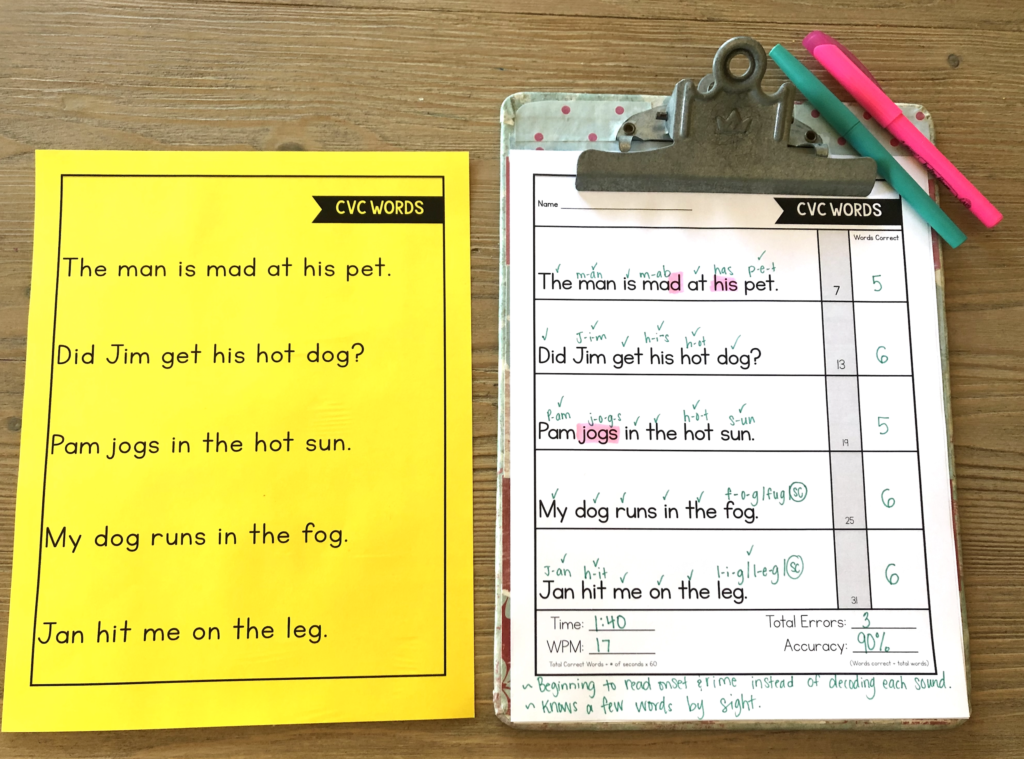
The assessment above shows me that this student has some word recognition (words they know and do not need to sound out) and they are able to decode CVC words. I can see that they have some issues with b/d confusion, e/i substitution, and suffix -s may be a challenge. Since I took this picture a few years ago, I have updated the bottom portion. I no longer look at words per minute. Instead, I have a fluency rubric, which I think provides more information. Based on this, I think my student is able to move on to the next skill, but I will continue to focus on b/d and short e and provide extra opportunities to practice reading decodable sentences. Since they are mostly accurate with CVC words, this can be done during independent time.
Example 2
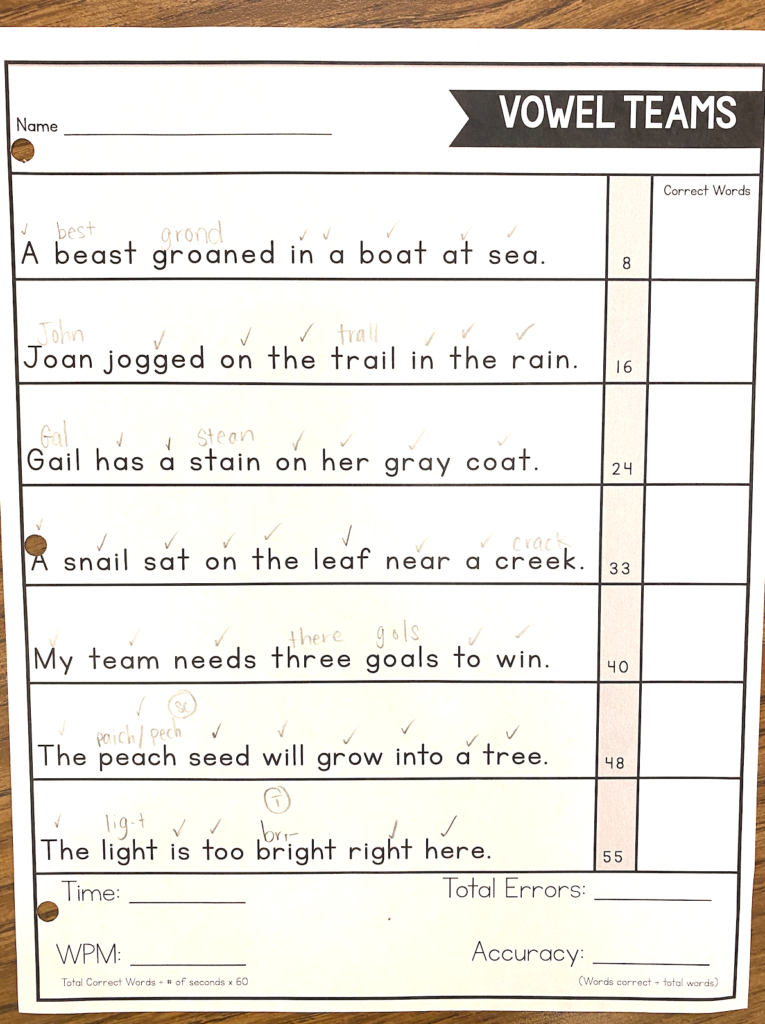
This assessment shows me that the student has several words they recognize. Those are words with the check mark. However, notice how whenever the student did not know a word and had to decode it, they were inaccurate. Some examples include best/beast, grond/groaned, John/Joan, Gal/Gail, stean/stain, paich/pech/peach, gols/goals. This means that they do not have proficiency with those vowel teams. This shows me I need to provide more instruction with those graphemes and application practice with those graphemes.
I had another instance where the accuracy was 100%. The student was able to decode every word, applying their knowledge of those vowel teams. However, they had to decode almost every single word. There was very little word recognition. This tells me that the student does not need more instruction with those graphemes. They need more practice and time applying their new learning. They need to be given plenty of opportunities to read decodable phrases and sentences.
Phonics Assessment Resources
Phonics Skill Check for Every Skill
If you like this format, check out my Phonics Assessments. This resource includes decoding words, encoding (spelling) assessments, and decodable sentences for several different phonetic elements. There is also an editable tracking page.
The skills include CVC words, digraphs, blends, closed syllable exceptions, open syllables, silent e, long vowel teams, r-controlled vowels, other vowel teams/diphthongs, and two-syllable words.
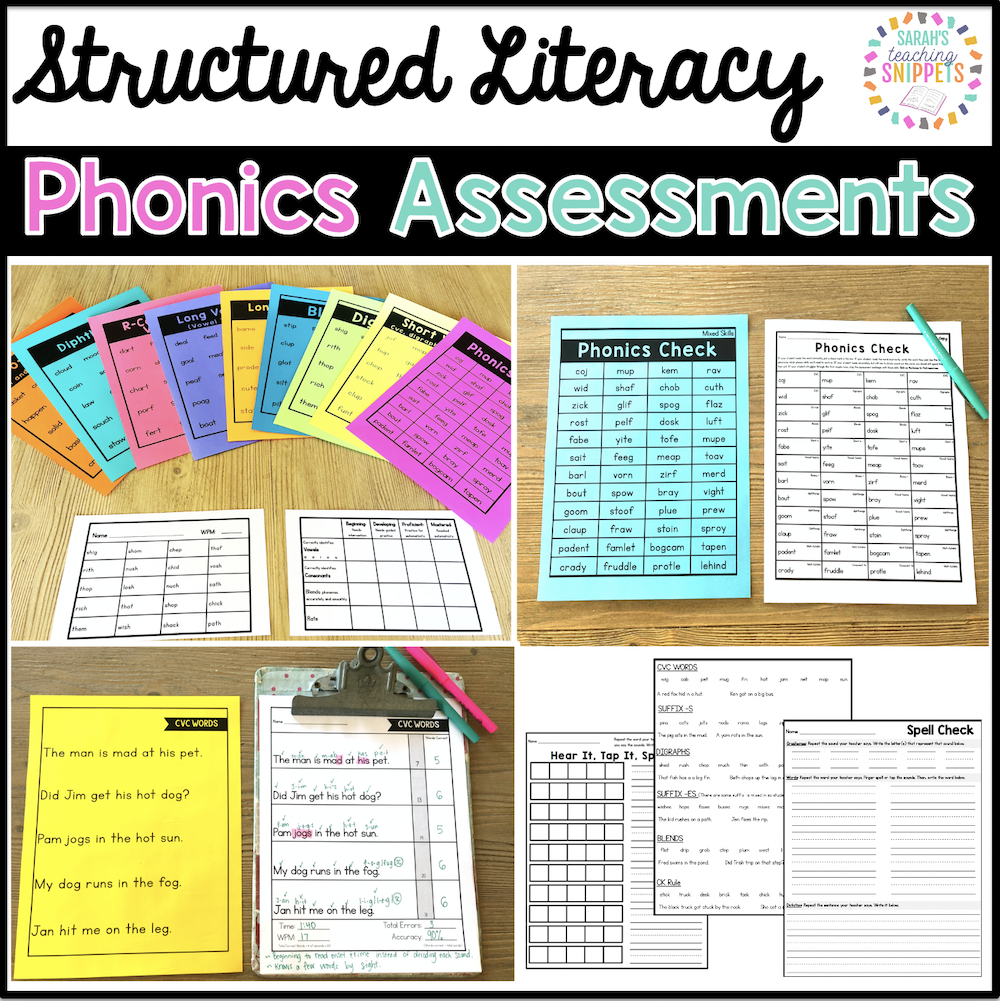
You can find this phonics assessment resource here.
Phonics Diagnostic (Placement Assessment)
This free resource is for the initial assessment so you can determine what your students know and where to begin instruction.
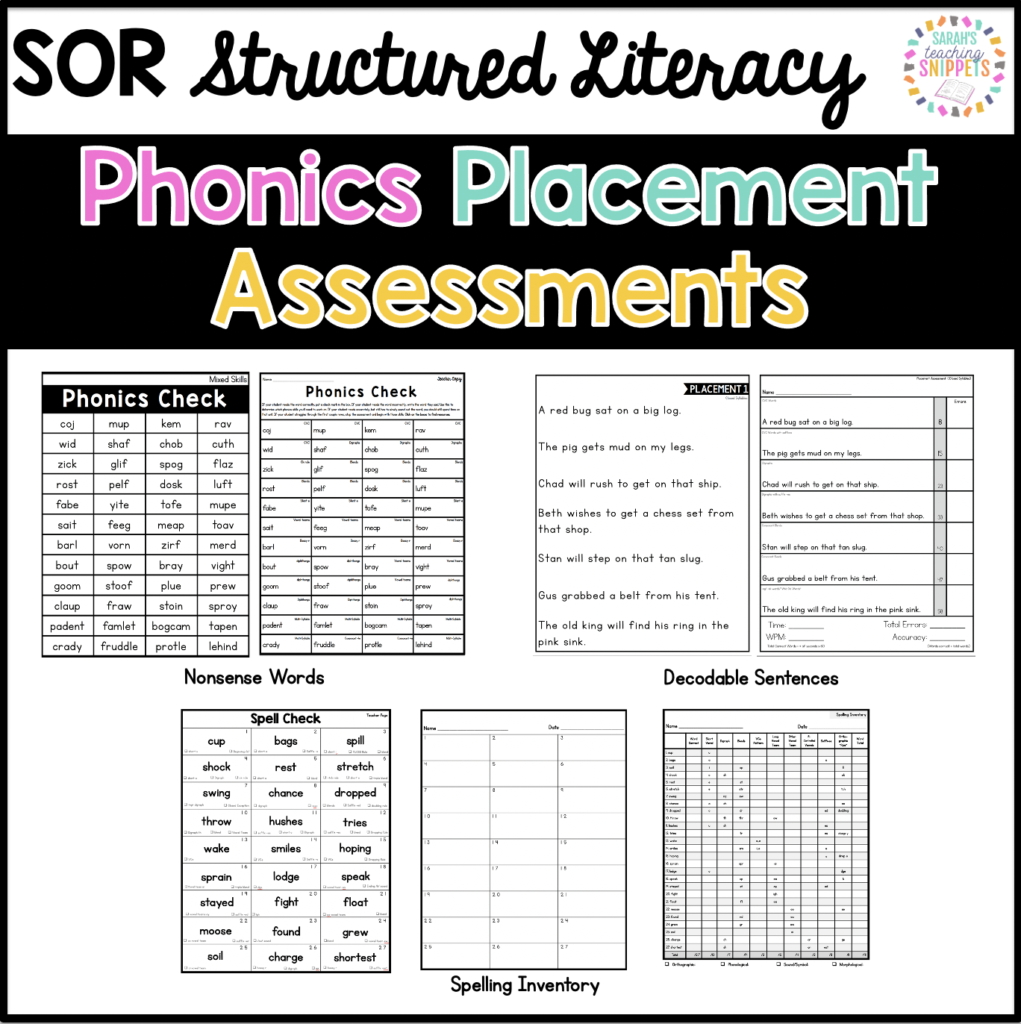
This assessment has a word reading assessment, encoding (spelling assessment), and decodable sentence assessment.
Organizing the Phonics Assessments
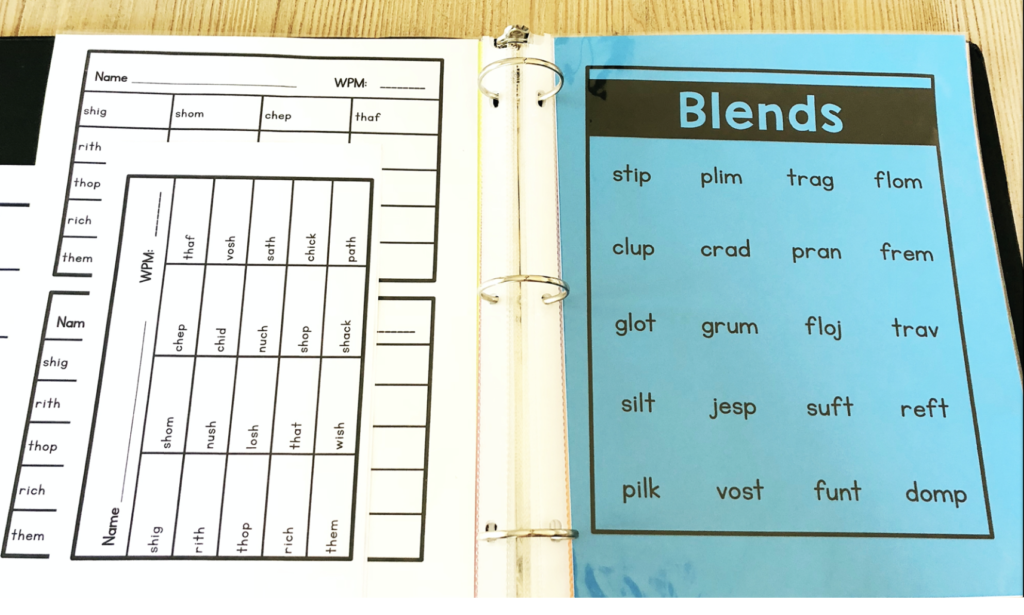
This is how I organize my assessments. I print each on a different color (totally unnecessary, just pleasing to my eye). I put these student pages in a page protector. On the other side, I put the master of the teacher page along with a few copies of each tucked inside (see above). I keep the word lists that can be used for the spelling assessments right after those pages.
Other Assessments
If you teach kindergarten, begin with phonemic awareness and alphabet knowledge for assessments.
- You can find free phonemic awareness assessments here
- You can find a free alphabet knowledge assessment here.
- If a student is proficient with both, then you can start the CVC word assessment.
Alphabet Assessment
This alphabet assessment will help you determine which letters your students know and which letters they need to learn. I assess both letter recognition and sound-symbol knowledge for each letter. You can find this free assessment here.
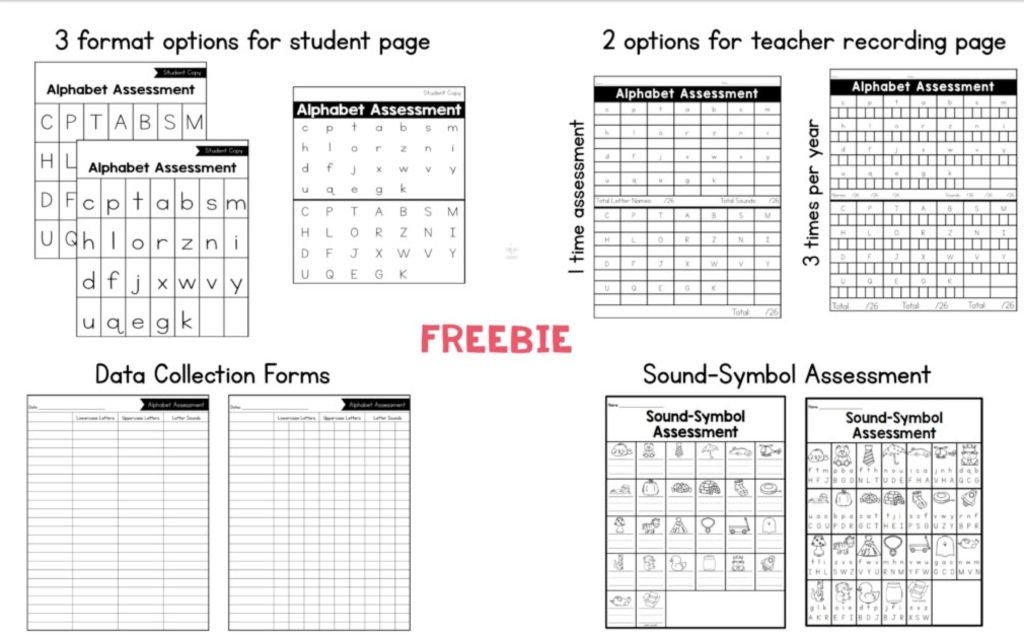
Phonemic Awareness Assessment
I love this assessment because I learn so much from it! Phonemic awareness is one of the greatest indicators of reading success so it is essential that we assess our kindergarteners in this area.
I also like to use it because I end up seeing SO much growth over time. Most kindergarteners who don’t know how to blend or segment phonemes when they first arrive in kindergarten end up picking it up after some instruction and daily practice. By the time I assess again in November or December, I already see huge gains for most of them. The students who don’t make gains need additional intervention with phonemic awareness. Early intervention with phonemic awareness can be so powerful and make a huge difference!
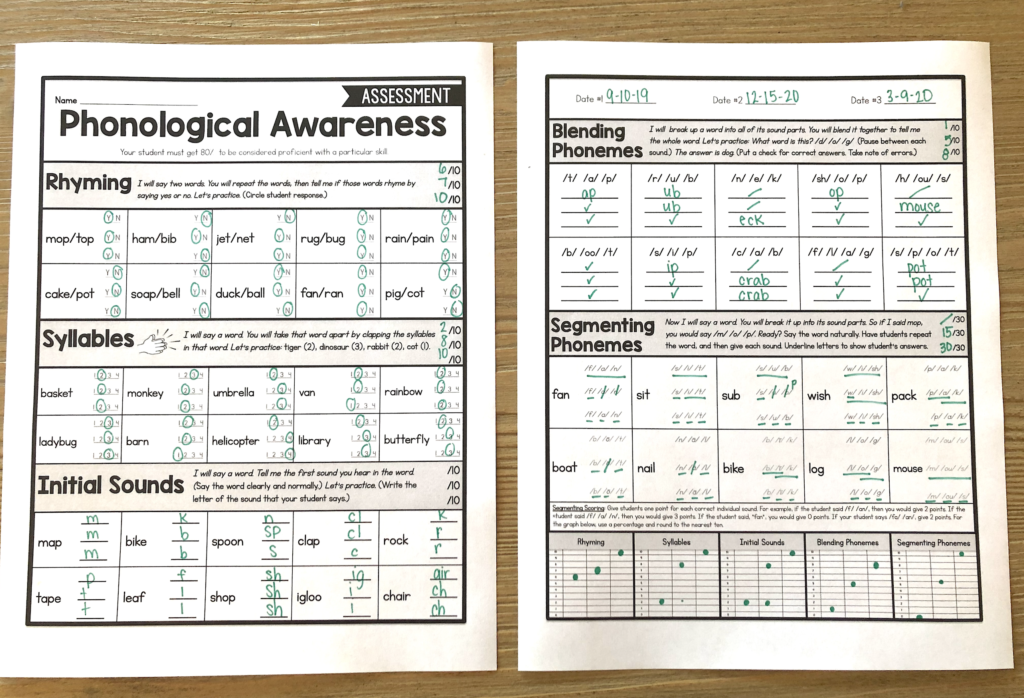
There is space provided for three assessments throughout the year, but some of your students will not need to be assessed all three times. Some may need to be assessed more than three times. I recently updated this with the little graph on the bottom because I wanted to see the growth throughout the year. I pay closest attention to the blending and segmenting progress. At the beginning of the year, it is not unusual for kindergarten students to lack these skills. However, most are pretty proficient by midyear, especially after instruction and practice.
You can find this free assessment here.
Providing Intervention
So what should you do when one of your students is struggling in one or more of these areas? I have collections of blog posts that may help!
